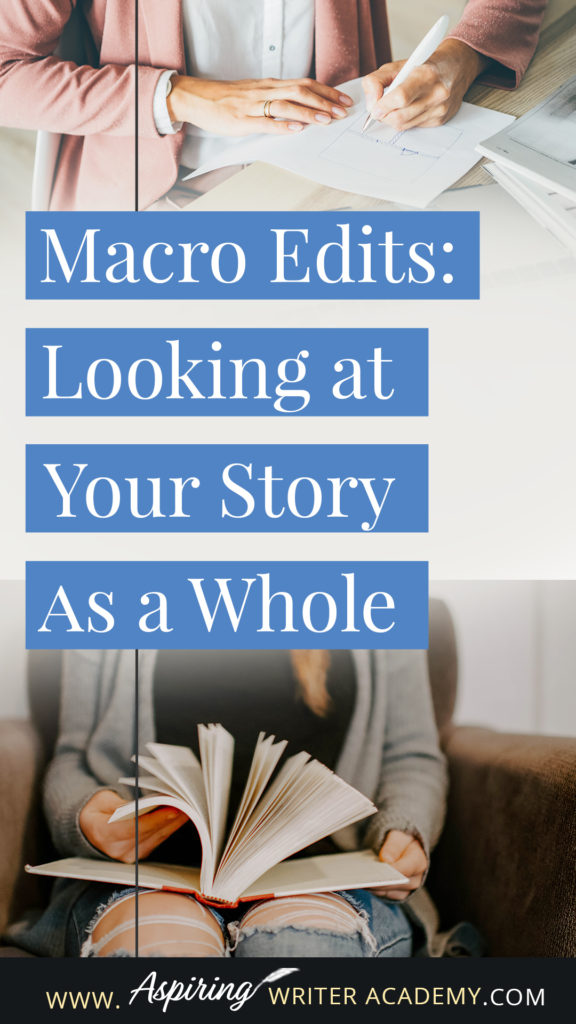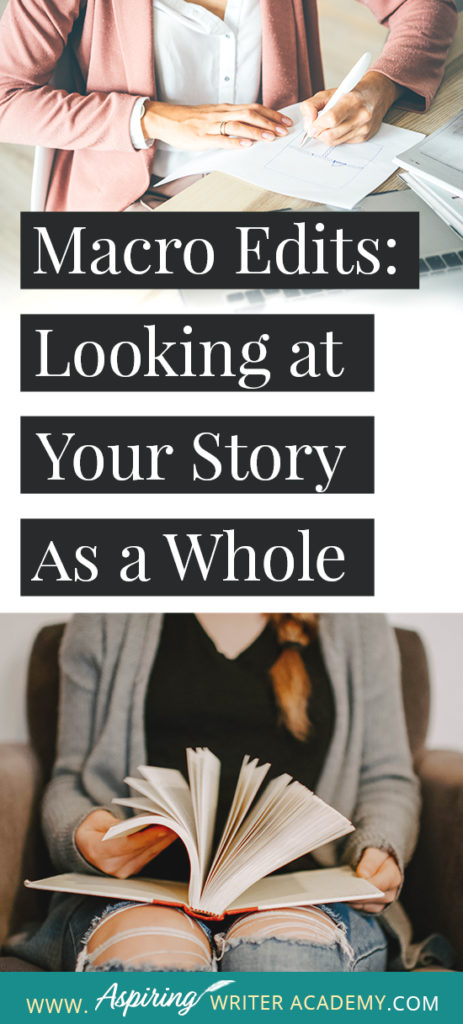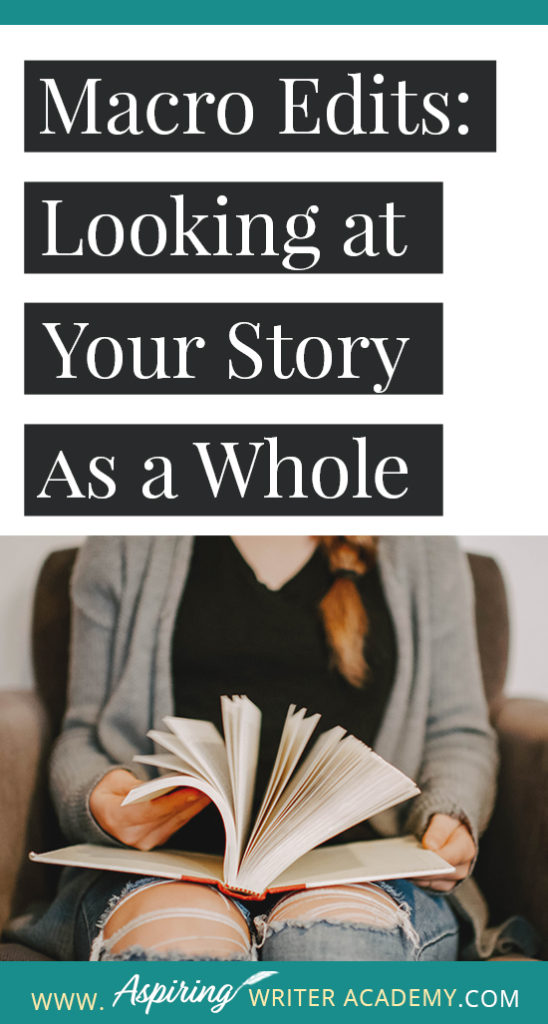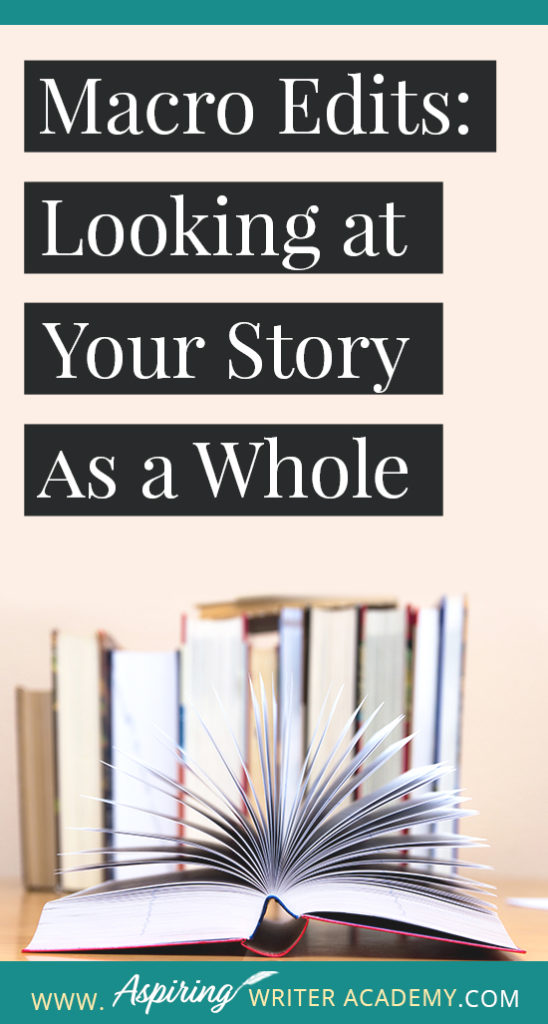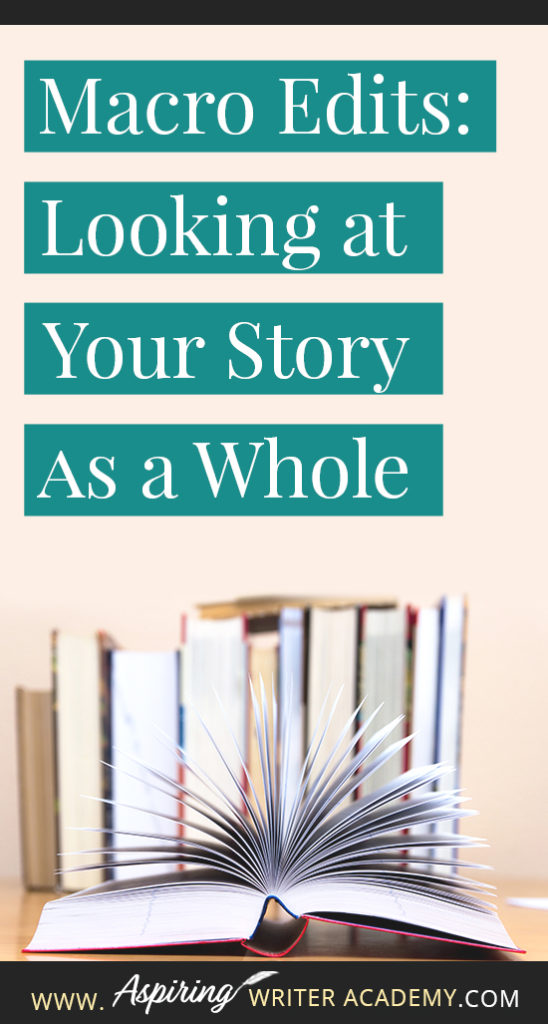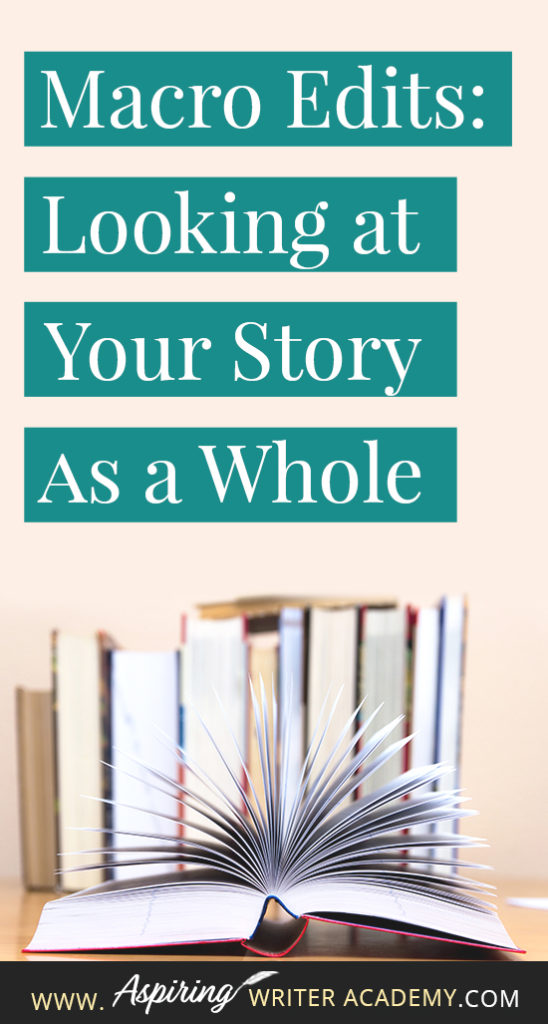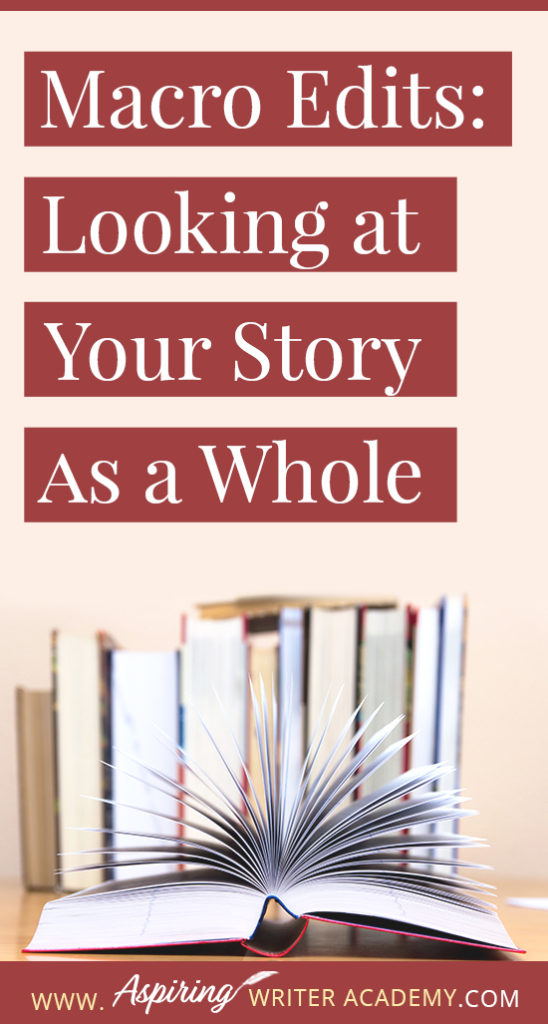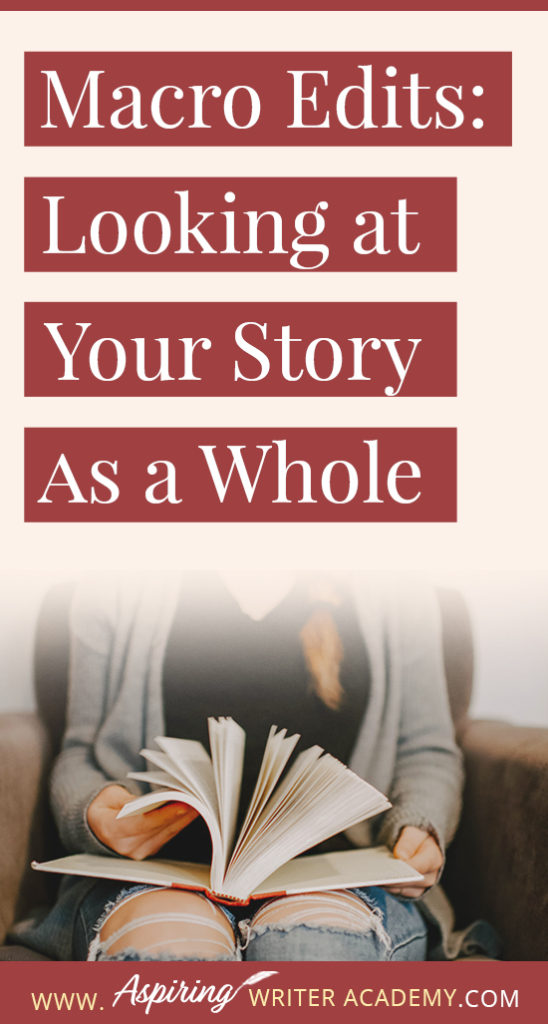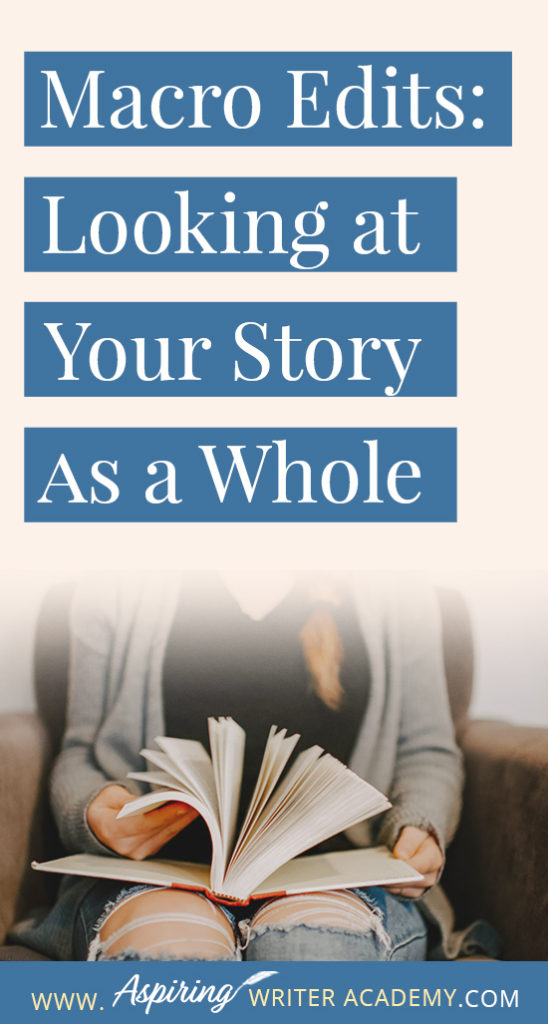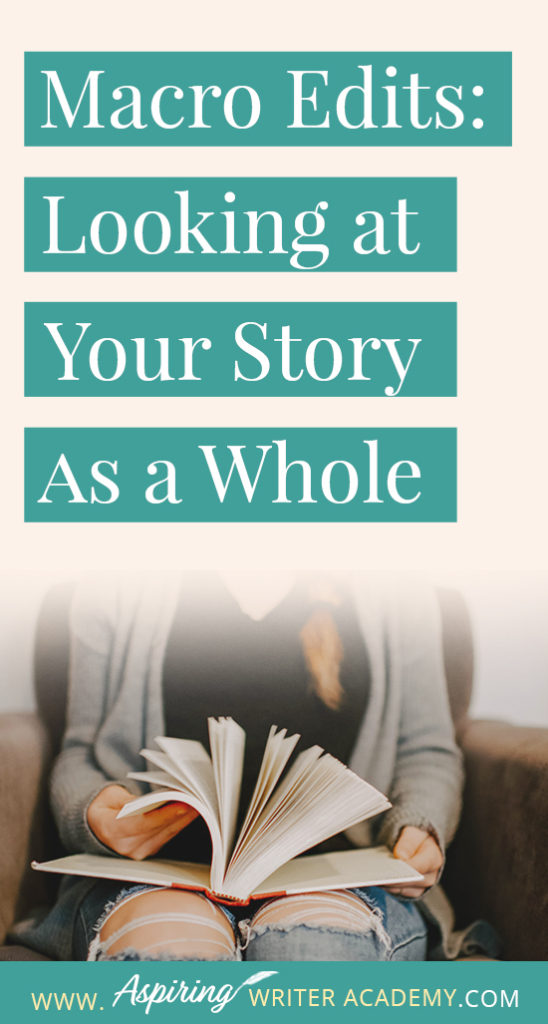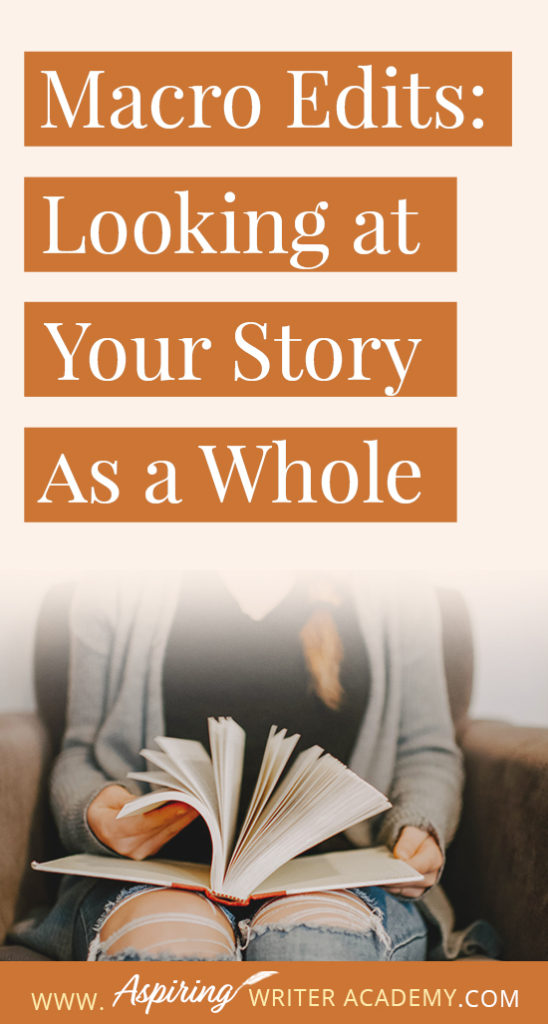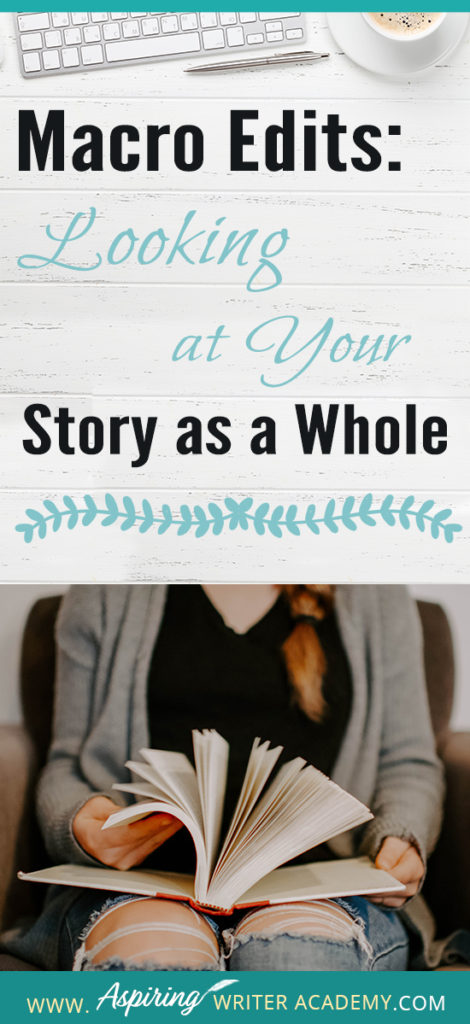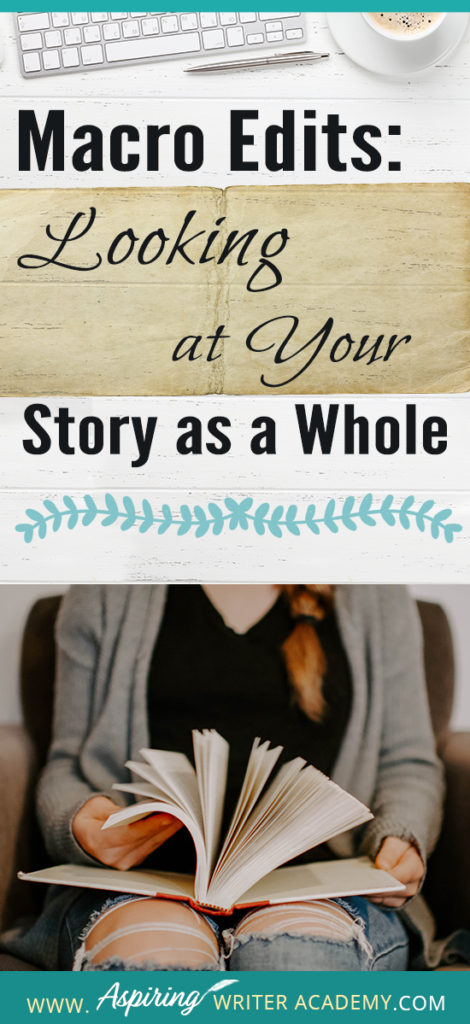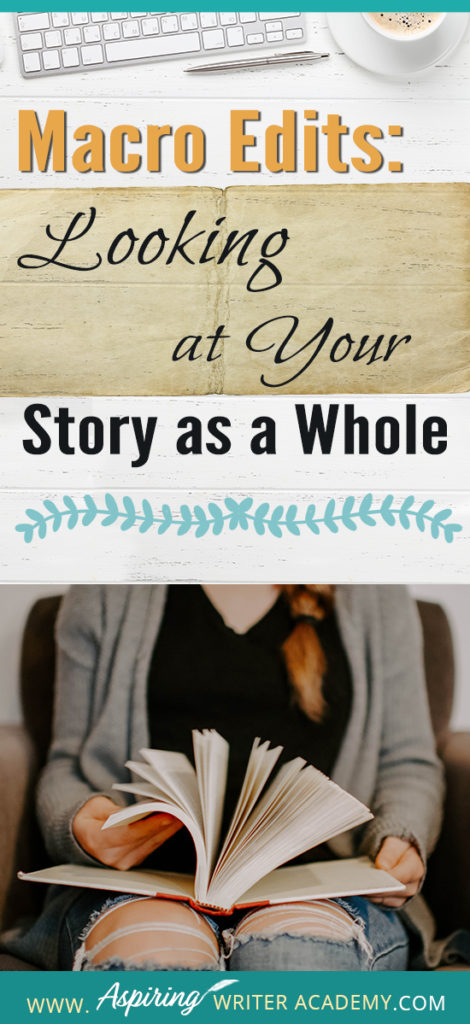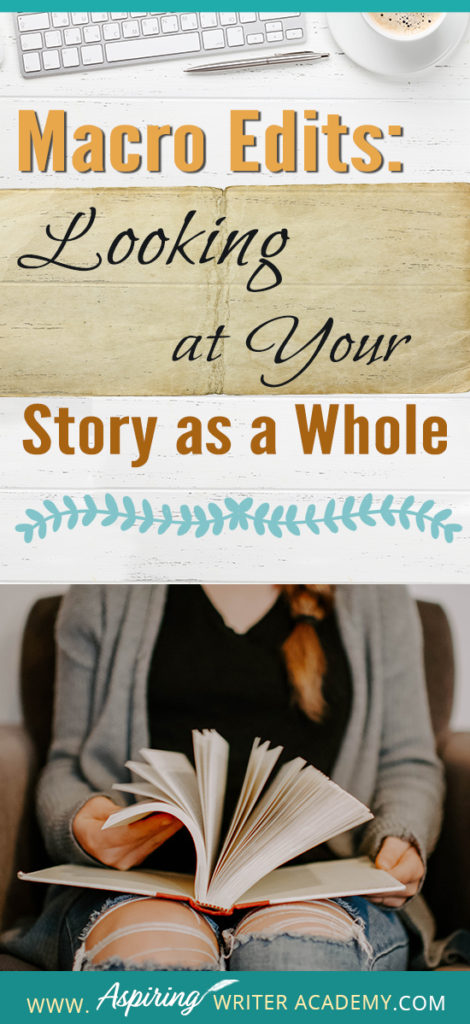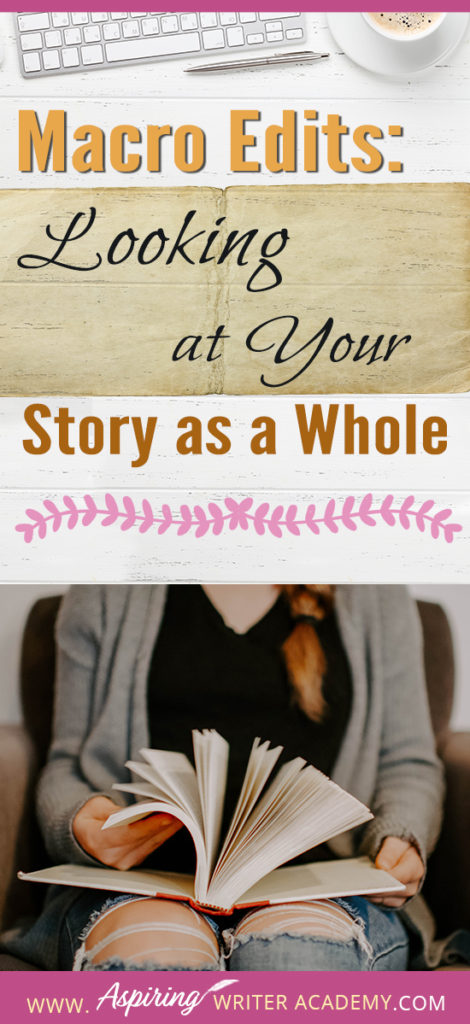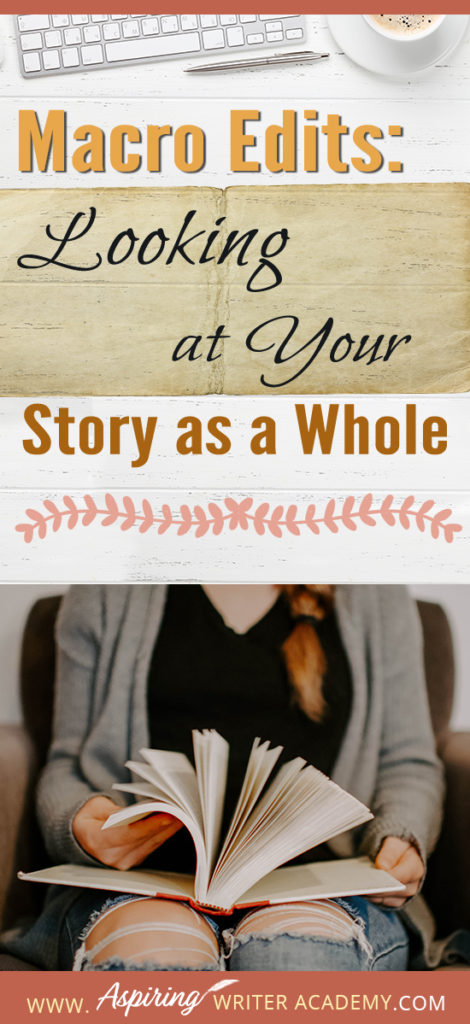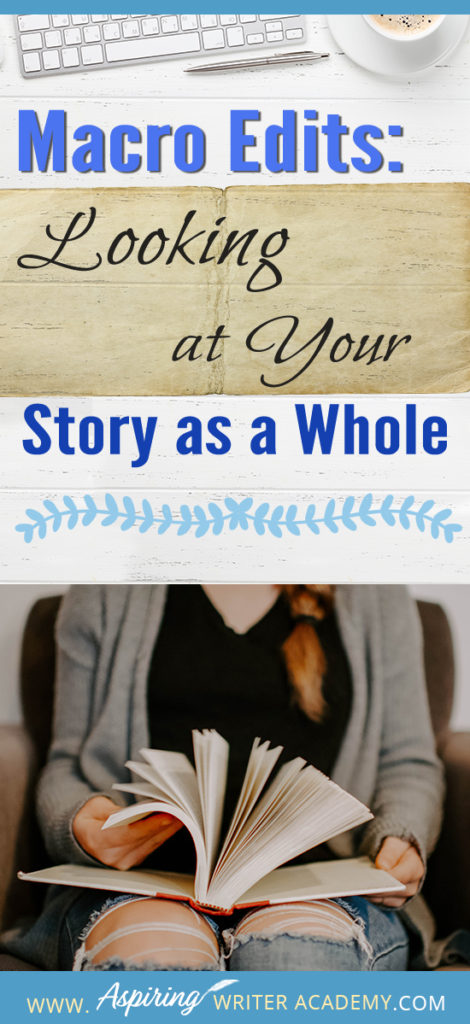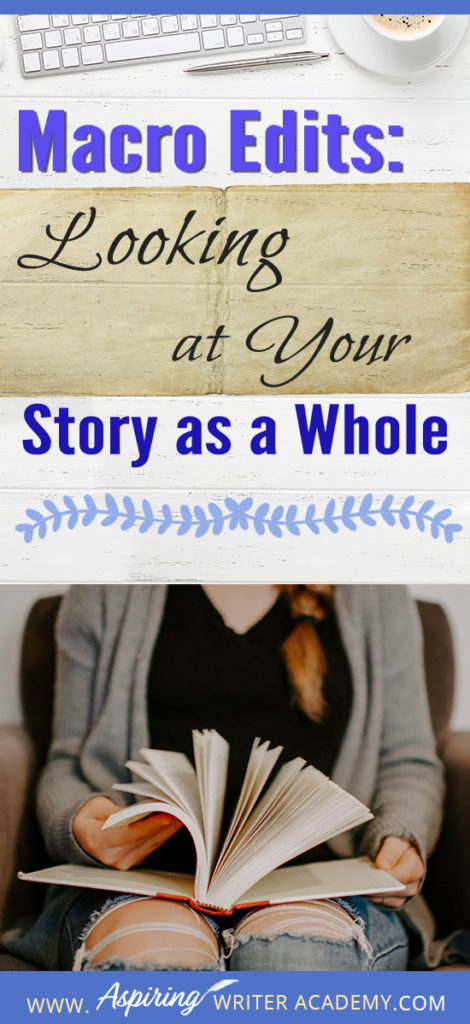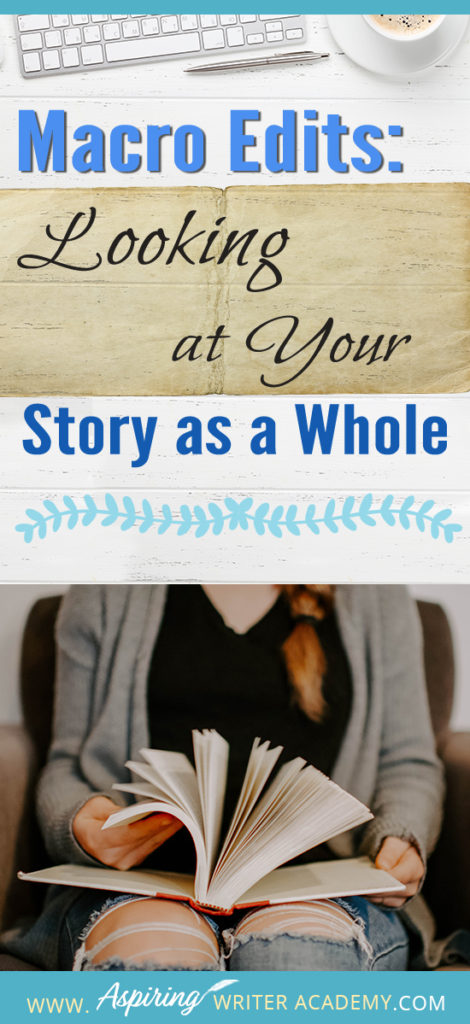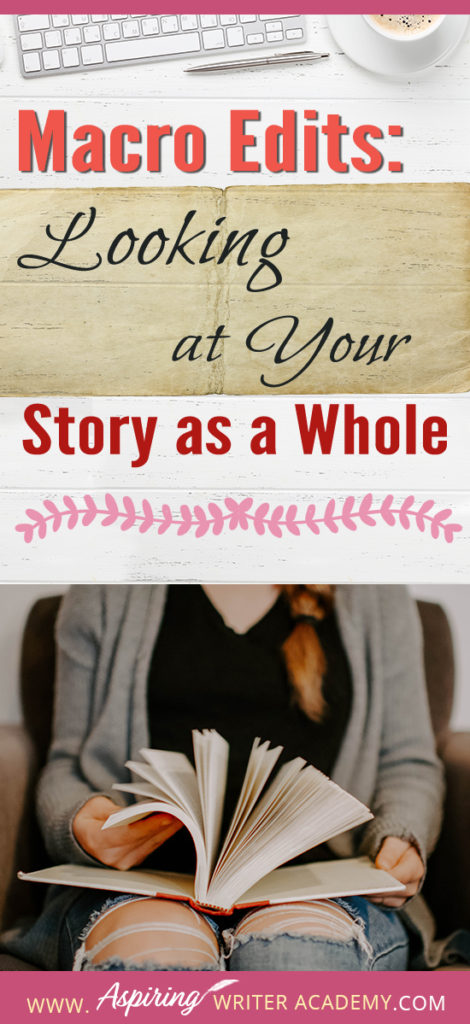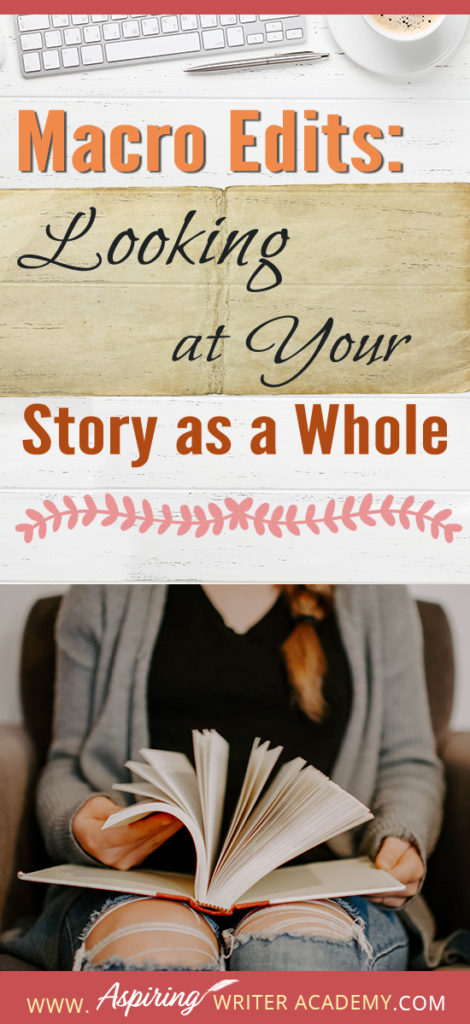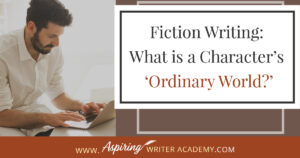Macro Edits: Looking at Your Story as a Whole
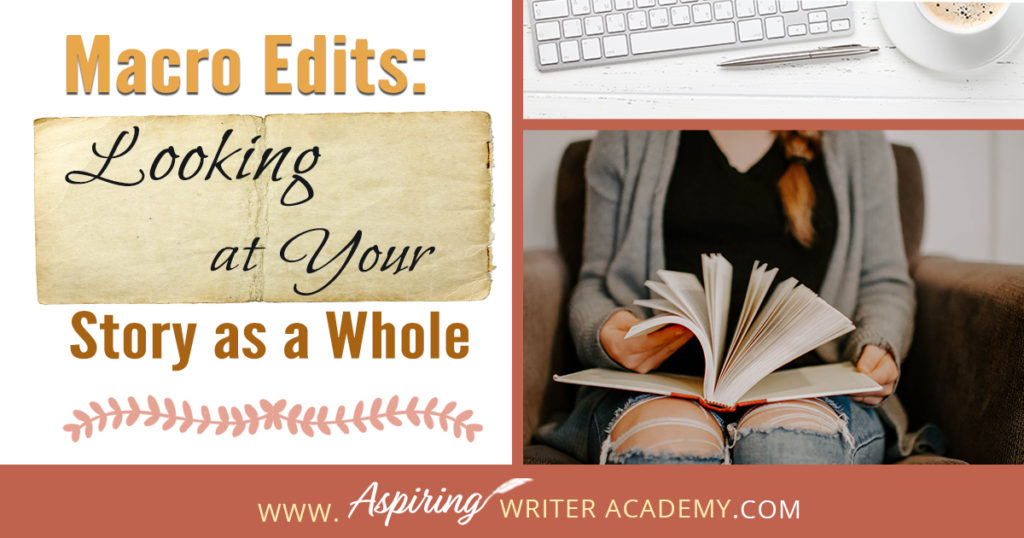
After you have finished writing the first full draft of your novel, you may want to set it aside for a few weeks before going straight into edits to give your brain time to refresh. Giving yourself time to distance from the story allows you to come back to it with a different perspective. This is exactly what you will need for the first round of revision—macro edits.
Macro editing looks at the whole story from beginning to end to see if the story makes sense, the characters are consistent with their personality, the plot structure is set up properly and functions to push the story forward.
- You may want to look for any ‘holes’ or sections of the story that need a little more detail. Is everything believable or at least plausible and properly explained?
- Are any scenes missing which need to be added?
- Are there any scenes included that are pointless or repetitive and should be deleted?
- Have any characters ‘dropped off the page’ where you need to explain where they went?
- Or did you forget about a character who should be included in certain events?
- Is the story timeline (passage of days, weeks, months) consistent with a real calendar?
- How is the pacing? If your story meanders slowly through the first 200 pages and then revs up in speed and races toward the end, you may want to make some adjustments.
- Are the key points or “bones” of your plot consistent with proper story structure?
- What is the overall tone of your story? Does it convey the right mood or does something feel ‘off’ in certain sections?
There is no point in doing line edits that focus on grammar and punctuation if you might have to do heavy revising that could possibly cut scenes. That is why we look at doing Macro Edits: Looking at the Story as a Whole first before digging deeper. Macro edits can save a writer a lot of wasted time.
(Helpful Hint) This is why it would also be wise for an aspiring writer to nail down their story premise and plot line first before writing the entire book. You do not want to write 300 pages only to find that you do not have a real story worthy of publication (if that is your intent).
Below are 5 important “big-picture” questions to help you with macro edits as you begin the revision phase:

1) Where does the first real action sequence start?
If your story starts with a lot of explanation or backstory and/or the main character’s introspection or internal thoughts, then you may find you need to cut the first 7-12 pages. Some writers may cringe to find they need to cut off the first 3 chapters. Although there are exceptions to every rule, generally it is advised that you should never begin with backstory. Backstory explains about characters and events that happened prior to the current story. Instead, start with action.
*To grip the reader from page 1 and entice them to keep reading, you need to have something interesting happening in the current timeframe of the story right from the first line/first paragraph.
The reader does not have to know everything that happened in the past. It is your job, as the author, to seed some of that information into the story in bits and pieces as the present story unfolds. Preferably, do not have any large chunks of backstory in the first 3 chapters of your novel. Only include a line or two of critical need-to-know information to enable the reader to understand what is going on in the present scene. Later in the story, perhaps around the midpoint, you will have room to explain more.
And if you find you are writing more text inside the character’s thoughts instead of actual dialogue or action on the page, you might first consider: what kind of novel are you writing?
If you are writing a memoir or documentary or introspective literary piece, this might be just fine. But if you are writing a romance, murder mystery, suspense, fantasy or for any of the mainstream popular genres, then you need to cut some of the character’s introspection and move the vital information into dialogue with other characters.
Exercise: To clearly see what kind of action-oriented vs. introspective balance you have on the page, highlight in green all the lines that convey action and highlight in pink all the internal thoughts of the character and non-action details. What do you see?
Today’s reader wants to see the story actively unfolding. Introspection slows down the pacing of the story and most times is not as interesting as an action scene. A book with too much internal thought and not enough action may be tossed across the floor.
Does your story contain real scenes? Or are you ‘Telling’ the story and not ‘Showing’ the story as it unfolds in real time without the need for explanation? This is what editors and agents at conferences mean when they say, “Show, Don’t Tell!”

2) Have you included action-oriented scenes that contain forward movement?
By “action” we do not mean there has to be an actual fight or explosion with people running, but there should be forward movement. Even if two elderly ladies are having a soft-spoken verbal disagreement, there must be a definitive goal or desired outcome, an exchange causing conflict, and an end result that pushes the character and plot forward.
Can you tell where one scene ends and another scene begins? Again, do you even have real scenes? Or do your characters go around talking to one person and then the next without any clear vision of what they want? Does the main character drive the action that is unfolding or is he simply reacting to events that are happening to him? Your character should be active not reactive.
- Your main character should enter each scene with a goal. There should be another character in that scene who opposes or tries to stop the main character from achieving that goal, causing conflict. There should be at least 3 back and forth exchanges between them as they battle either verbally or physically. The character will either succeed or fail to achieve the scene goal. The result should lead the main character to formulate his next scene goal, which he will take action upon in the next scene. These are the components that constitute a real “scene.”
Exercise: Look at your scenes and identify the goal, conflict, and resolution. Can you revise to make these elements even stronger? How could the scene ending complicate things and contain more dire consequences for the main character?

3) Do your action-oriented scenes focus on the main character and his attempt to achieve his story-worthy goal? Do the scenes connect like dominoes to push the story toward a climax and satisfying conclusion?
At the beginning of your story something unexpected should have happened to your main character to flip his ordinary world (day-to-day life) upside down. His life will never be right again until he deals with this ‘problem’ which demands a solution. How they decide to deal with this problem becomes his story-worthy goal, a goal that takes him on a ‘journey’ and is not fully achieved until the story’s end. You should be able to clearly summarize the goal in one sentence.
If you have trouble identifying your character’s story-worthy goal, you can download our free Brainstorming Your Story Idea Worksheet with templates to guide you.
*Each scene in your story should be focused on how the character is attempting to achieve their story-worthy goal to solve their unexpected ‘life-altering’ problem. The goal will involve several difficult steps which will take him the entire length of the story to achieve.
Exercise: If you haven’t outlined your story already, list each action-oriented scene in your novel and take a look at the line-up. What does each scene accomplish?
Do you have ‘repetitive’ type scenes or do your scenes move the story—the plot—forward? How does this scene lead the character to take the next step? Could this scene be deleted with no consequence? Could part of this scene be combined with another scene instead? How could you make this scene more interesting?
Do your scenes lead toward a climax, a showdown between the main character and the antagonist or story villain? You cannot have another character ride in to save the day or have a random outside event like a tornado touch down to wipe out the opposition. Your main character should be the one to stand up to the antagonist who is causing him trouble, face to face.
Hopefully over the course of the story your main character has learned some skills to defeat him. Is the wrap up or conclusion of your story plausible? If the main character uses something at the end to defeat his opponent, did you set it up (show it earlier) to make this believable?

4) Have your characters learned anything about themselves or about life during the course of this story? Have they changed at all?
Who was the character in the beginning? What did he learn during the course of the story? Who are they at the end? What kind of person? How did his life change?
*For a truly satisfying story, the main character should have a character arc. By going on the story journey to achieve his goal and deal with the initial unexpected problem that was dropped in his lap, the main character should grow and change and learn from the events happening to him in the plot. At the end of the story he should be a little better, wiser, or somehow different than he was at the beginning of the story.
Exercise: Go back over your scene list and see how each event led the character another step toward enlightenment or true growth or change.
At the end of the story, how can you show that the character has changed with action? What can he do now that he couldn’t do before?
To discover the arc, you might fill in these blanks for your character:
“I once was _____________________, but now I am ____________________.”
“Before, I could not ________________, but now I can ________________.”
Examples:
I once was lost, but now I see.
I once was unforgiving, but now I can forgive.
I could not walk, but now I can run.
I shied away from relationships, but now I can love, and I am getting married!
I knew nothing about cooking, but now I am a restaurant chef.
I could not let go of the past, but now I can get on with my life.
I did not believe in God, now I trust in Him.
I could not handle a weapon, now I am a great shot.
I once was afraid to swim, now I love to swim every day.
Did other characters in the story who were impacted by the events of the plot also change? How so? What was their character arc?

5) Does the story have a clear beginning, middle, and end?
- What was the initial problem the main character needed to solve? How did the plot evolve or change during the course of the story?
- Did the character gain some new insight or understanding, perhaps revealing why the antagonist is against him and how he might defeat him? Did he gain some new insight into himself?
- Did his goals change part way through? Sometimes the character gives up his initial goal for a better one. What inspired this change?
- Did the main character have to sacrifice anything during the course of the story or to get what he wanted at the end?
- How was the problem resolved?
- If you are writing a series, you might want to leave some small loose ends in a subplot to intrigue the reader to read the next book instead of wrapping everything up tight, but the main plot should have a satisfying conclusion.
* Resist the urge to tell the reader the lesson the character learned or moral of the story at the end. The character’s decisions and the story itself should covey the theme without it being stated. Don’t get preachy! Let the reader come to their own understanding of what the story meant. “Show, don’t tell.”
- Exercise: Summarize the beginning of the story, the middle, and the conclusion using one paragraph for each. Is it clear or is it jumbled? Does the progression make sense?
I hope these 5 questions in Macro Edits: Looking at the Story as a Whole will help you as you start in on round-one “large picture” edits for your story. Again, if you would like some extra help with character, plot, formulating the 3 paragraphs of the beginning, middle, and end, or would like to know how to create a one-line pitch, you can download our free Brainstorming Your Story Idea Worksheet with templates to guide you.
And if you have any questions, you can always reach us at https://www.aspiringwriteracademy.com/contact/

ENTER YOUR EMAIL BELOW
TO GET YOUR FREE
"Brainstorming Your Story Idea Worksheet"
7 easy fill-in-the-blank pages,
+ 2 bonus pages filled with additional story examples.
A valuable tool to develop story plots again and again.
Our Goal for Aspiring Writer Academy is to help people learn how to write quality fiction, teach them to publish and promote their work, and to give them the necessary tools to pursue a writing career.
If you have any questions or would like to leave a comment below, we would love to hear from you!
Other Blog Posts You May Like
Basic Story Structure: How to Plot in 6 Steps
Behind the Scenes: Interview with the Authors of the “Sew in Love” Collection
Our Inspiration For Writing A Historical Novella Collection
Brainstorming Story Ideas: Where to Find Them
Why We Started Aspiring Writer Academy: Our Story
Scene & Sequel: The Secret to Plotting an Epic Novel
Scene & Sequel: The Secret to Plotting an Epic Novel (Part 2)
Writing Fiction: How to Develop Your Story Premise
12 Quick Tips to Write Dazzling Dialogue
10 Questions to Ask When Creating Characters for Your Story
Macro Edits: Looking at Your Story as a Whole
Do you find it difficult to create compelling antagonists and villains for your stories? Do your villains feel cartoonish and unbelievable? Do they lack motivation or a specific game plan? Discover the secrets to crafting villains that will stick with your readers long after they finish your story, with our How to Create Antagonists & Villains Workbook.
This 32-page instructional workbook is packed with valuable fill-in-the-blank templates and practical advice to help you create memorable and effective antagonists and villains. Whether you're a seasoned writer or just starting out, this workbook will take your writing to the next level.

is a multi-published author, speaker, and writing coach. She writes sweet contemporary, inspirational, and historical romance and loves teaching aspiring writers how to write quality fiction. Read her inspiring story of how she published her first book and launched a successful writing career.

